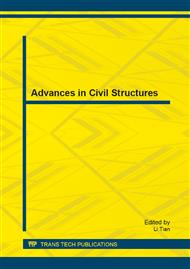p.1273
p.1278
p.1284
p.1289
p.1293
p.1298
p.1302
p.1306
p.1312
Study on Seismic Response Control of Self-Anchored Suspension Bridge with TMD
Abstract:
Large span self-anchored suspension bridges which are located in the strong earthquake zone often have no sufficient anti-seismic capacity, especially the bridge pylon. Therefore, seismic response control is necessary. This paper studies the lateral damping control effects of one large-span self-anchored suspension bridge with tuned mass damper (TMD). Using a spatial dynamic analysis finite element mode, the seismic responses are calculated out. Seismic response analysis results show that a large lateral displacement appeared at the pylon top under the lateral seismic action and the moment peak at the pylon bottom is nearly reaching its equivalent yield moment gotten by moment-curvature curve, which would be resulted in a high risk of collapse of self-anchored suspension bridge under lateral earthquake action. Therefore, one TMD is considered to be applied on the pylon top of the self-anchored suspension bridge to reduce the seismic response. The simulation result shows that the TMD can provide remarkable effect on seismic response control of the pylon. The control efficiency of TMD can be up to 23.4%. The moment at the pylon bottom and the displacement at the pylon top both decrease obviously. The parameter analyses of TMD are also performed to get the best design parameter. The research results can be used as the reference of seismic response control or anti-seismic design for the same type of bridge.
Info:
Periodical:
Pages:
1293-1297
Citation:
Online since:
August 2013
Authors:
Price:
Сopyright:
© 2013 Trans Tech Publications Ltd. All Rights Reserved
Share:
Citation:


